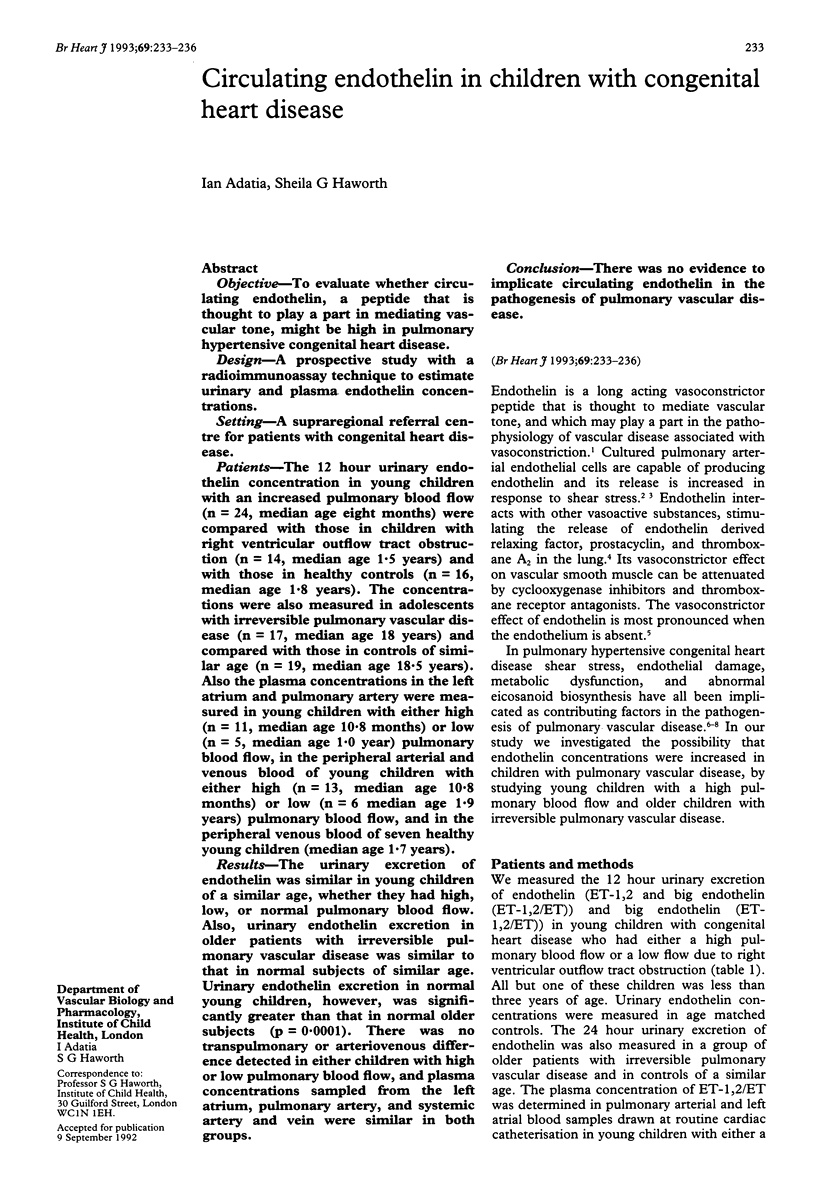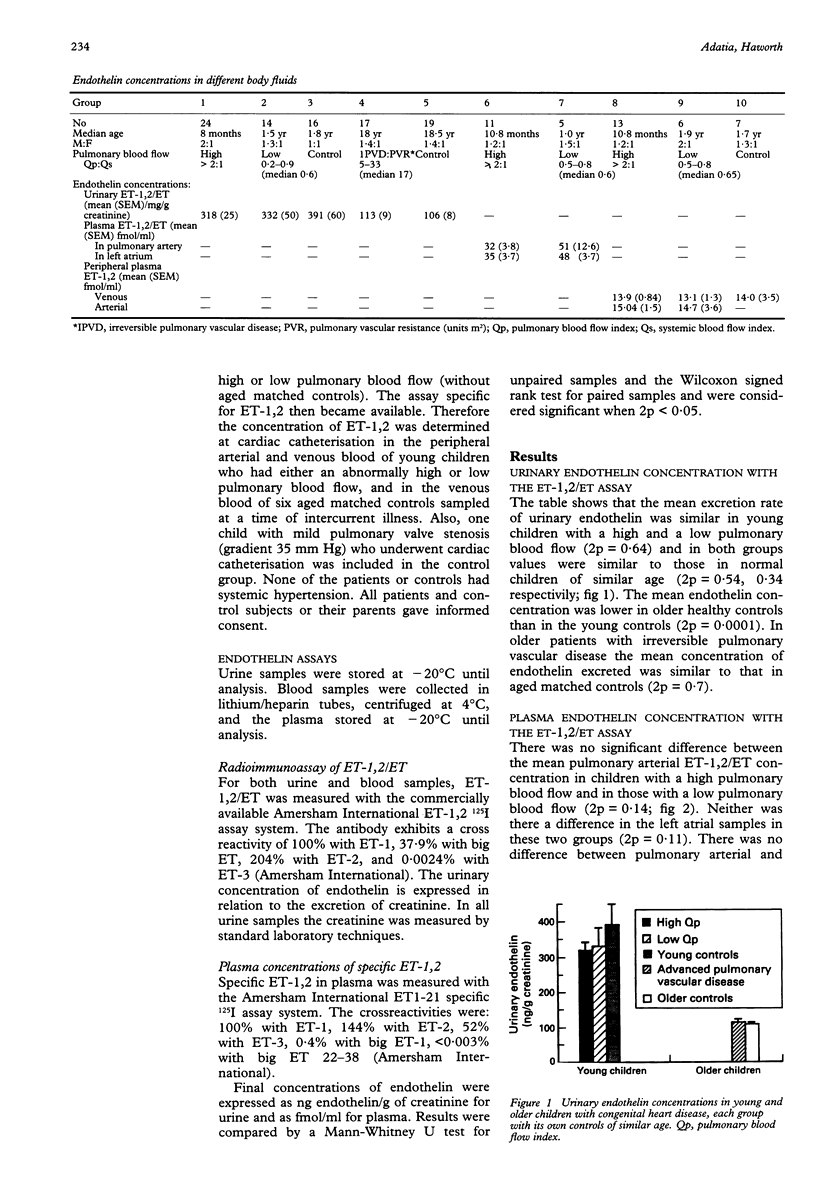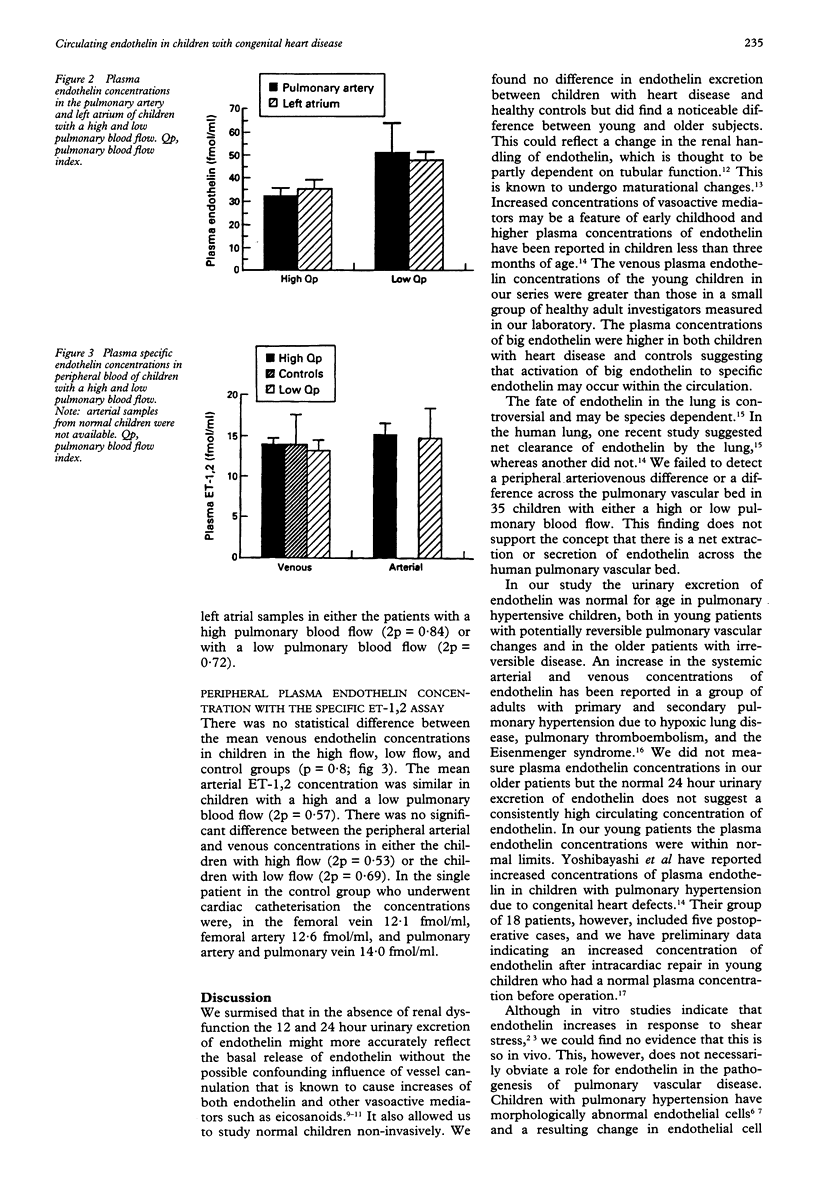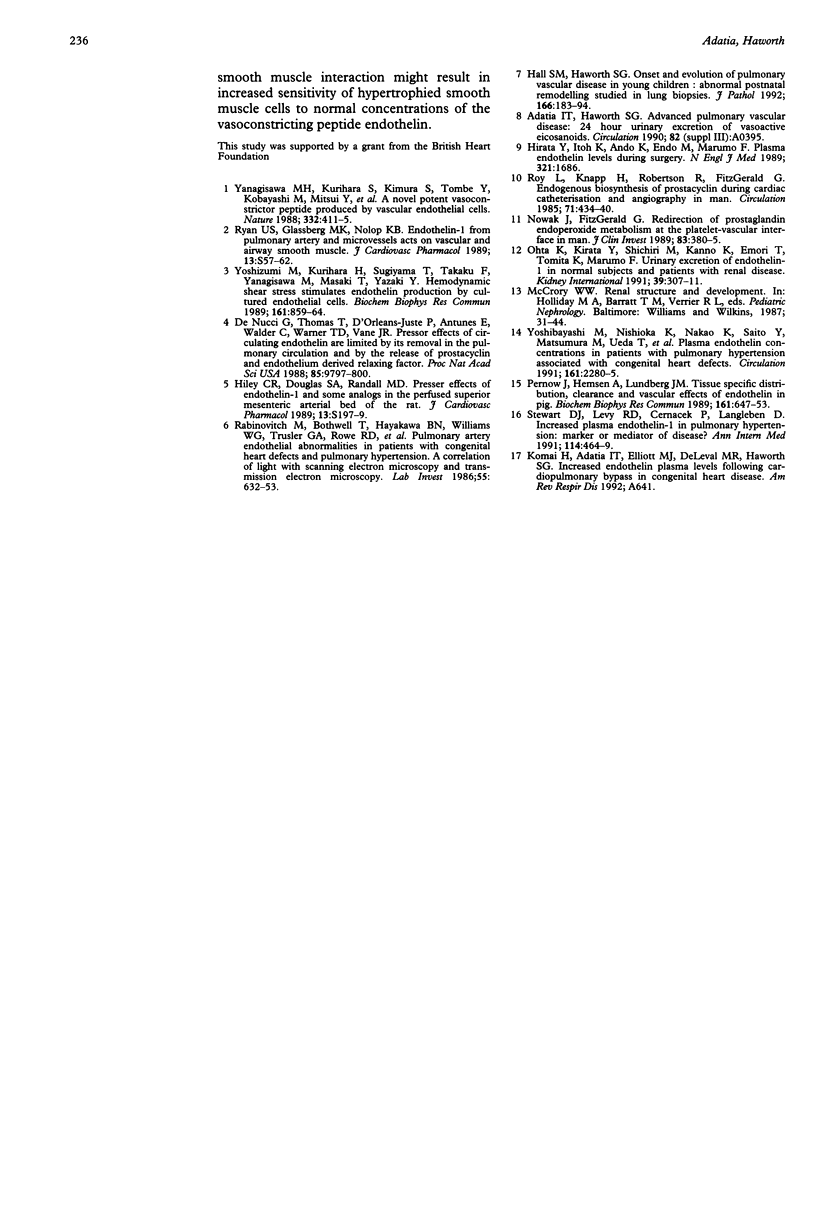Abstract
OBJECTIVE--To evaluate whether circulating endothelin, a peptide that is thought to play a part in mediating vascular tone, might be high in pulmonary hypertensive congenital heart disease. DESIGN--A prospective study with a radioimmunoassay technique to estimate urinary and plasma endothelin concentrations. SETTING--A supraregional referral centre for patients with congenital heart disease. PATIENTS--The 12 hour urinary endothelin concentration in young children with an increased pulmonary blood flow (n = 24, median age eight months) were compared with those in children with right ventricular outflow tract obstruction (n = 14, median age 1.5 years) and with those in healthy controls (n = 16, median age 1.8 years). The concentrations were also measured in adolescents with irreversible pulmonary vascular disease (n = 17, median age 18 years) and compared with those in controls of similar age (n = 19, median age 18.5 years). Also the plasma concentrations in the left atrium and pulmonary artery were measured in young children with either high (n = 11, median age 10.8 months) or low (n = 5, median age 1.0 year) pulmonary blood flow, in the peripheral arterial and venous blood of young children with either high (n = 13, median age 10.8 months) or low (n = 6 median age 1.9 years) pulmonary blood flow, and in the peripheral venous blood of seven healthy young children (median age 1.7 years). RESULTS--The urinary excretion of endothelin was similar in young children of a similar age, whether they had high, low, or normal pulmonary blood flow. Also, urinary endothelin excretion in older patients with irreversible pulmonary vascular disease was similar to that in normal subjects of similar age. Urinary endothelin excretion in normal young children, however, was significantly greater than that in normal older subjects (p = 0.0001). There was no transpulmonary or arteriovenous difference detected in either children with high or low pulmonary blood flow, and plasma concentrations sampled from the left atrium, pulmonary artery, and systemic artery and vein were similar in both groups. CONCLUSION--There was no evidence to implicate circulating endothelin in the pathogenesis of pulmonary vascular disease.
Full text
PDF



Selected References
These references are in PubMed. This may not be the complete list of references from this article.
- Hall S. M., Haworth S. G. Onset and evolution of pulmonary vascular disease in young children: abnormal postnatal remodelling studied in lung biopsies. J Pathol. 1992 Feb;166(2):183–193. doi: 10.1002/path.1711660216. [DOI] [PubMed] [Google Scholar]
- Hiley C. R., Douglas S. A., Randall M. D. Pressor effects of endothelin-1 and some analogs in the perfused superior mesenteric arterial bed of the rat. J Cardiovasc Pharmacol. 1989;13 (Suppl 5):S197–S199. doi: 10.1097/00005344-198900135-00055. [DOI] [PubMed] [Google Scholar]
- Hirata Y., Itoh K., Ando K., Endo M., Marumo F. Plasma endothelin levels during surgery. N Engl J Med. 1989 Dec 14;321(24):1686–1686. doi: 10.1056/NEJM198912143212420. [DOI] [PubMed] [Google Scholar]
- Nowak J., FitzGerald G. A. Redirection of prostaglandin endoperoxide metabolism at the platelet-vascular interface in man. J Clin Invest. 1989 Feb;83(2):380–385. doi: 10.1172/JCI113895. [DOI] [PMC free article] [PubMed] [Google Scholar]
- Ohta K., Hirata Y., Shichiri M., Kanno K., Emori T., Tomita K., Marumo F. Urinary excretion of endothelin-1 in normal subjects and patients with renal disease. Kidney Int. 1991 Feb;39(2):307–311. doi: 10.1038/ki.1991.38. [DOI] [PubMed] [Google Scholar]
- Pernow J., Hemsén A., Lundberg J. M. Tissue specific distribution, clearance and vascular effects of endothelin in the pig. Biochem Biophys Res Commun. 1989 Jun 15;161(2):647–653. doi: 10.1016/0006-291x(89)92648-x. [DOI] [PubMed] [Google Scholar]
- Rabinovitch M., Bothwell T., Hayakawa B. N., Williams W. G., Trusler G. A., Rowe R. D., Olley P. M., Cutz E. Pulmonary artery endothelial abnormalities in patients with congenital heart defects and pulmonary hypertension. A correlation of light with scanning electron microscopy and transmission electron microscopy. Lab Invest. 1986 Dec;55(6):632–653. [PubMed] [Google Scholar]
- Roy L., Knapp H. R., Robertson R. M., FitzGerald G. A. Endogenous biosynthesis of prostacyclin during cardiac catheterization and angiography in man. Circulation. 1985 Mar;71(3):434–440. doi: 10.1161/01.cir.71.3.434. [DOI] [PubMed] [Google Scholar]
- Ryan U. S., Glassberg M. K., Nolop K. B. Endothelin-1 from pulmonary artery and microvessels acts on vascular and airway smooth muscle. J Cardiovasc Pharmacol. 1989;13 (Suppl 5):S57–S74. doi: 10.1097/00005344-198900135-00014. [DOI] [PubMed] [Google Scholar]
- Stewart D. J., Levy R. D., Cernacek P., Langleben D. Increased plasma endothelin-1 in pulmonary hypertension: marker or mediator of disease? Ann Intern Med. 1991 Mar 15;114(6):464–469. doi: 10.7326/0003-4819-114-6-464. [DOI] [PubMed] [Google Scholar]
- Yanagisawa M., Kurihara H., Kimura S., Tomobe Y., Kobayashi M., Mitsui Y., Yazaki Y., Goto K., Masaki T. A novel potent vasoconstrictor peptide produced by vascular endothelial cells. Nature. 1988 Mar 31;332(6163):411–415. doi: 10.1038/332411a0. [DOI] [PubMed] [Google Scholar]
- Yoshibayashi M., Nishioka K., Nakao K., Saito Y., Matsumura M., Ueda T., Temma S., Shirakami G., Imura H., Mikawa H. Plasma endothelin concentrations in patients with pulmonary hypertension associated with congenital heart defects. Evidence for increased production of endothelin in pulmonary circulation. Circulation. 1991 Dec;84(6):2280–2285. doi: 10.1161/01.cir.84.6.2280. [DOI] [PubMed] [Google Scholar]
- Yoshizumi M., Kurihara H., Sugiyama T., Takaku F., Yanagisawa M., Masaki T., Yazaki Y. Hemodynamic shear stress stimulates endothelin production by cultured endothelial cells. Biochem Biophys Res Commun. 1989 Jun 15;161(2):859–864. doi: 10.1016/0006-291x(89)92679-x. [DOI] [PubMed] [Google Scholar]
- de Nucci G., Thomas R., D'Orleans-Juste P., Antunes E., Walder C., Warner T. D., Vane J. R. Pressor effects of circulating endothelin are limited by its removal in the pulmonary circulation and by the release of prostacyclin and endothelium-derived relaxing factor. Proc Natl Acad Sci U S A. 1988 Dec;85(24):9797–9800. doi: 10.1073/pnas.85.24.9797. [DOI] [PMC free article] [PubMed] [Google Scholar]


